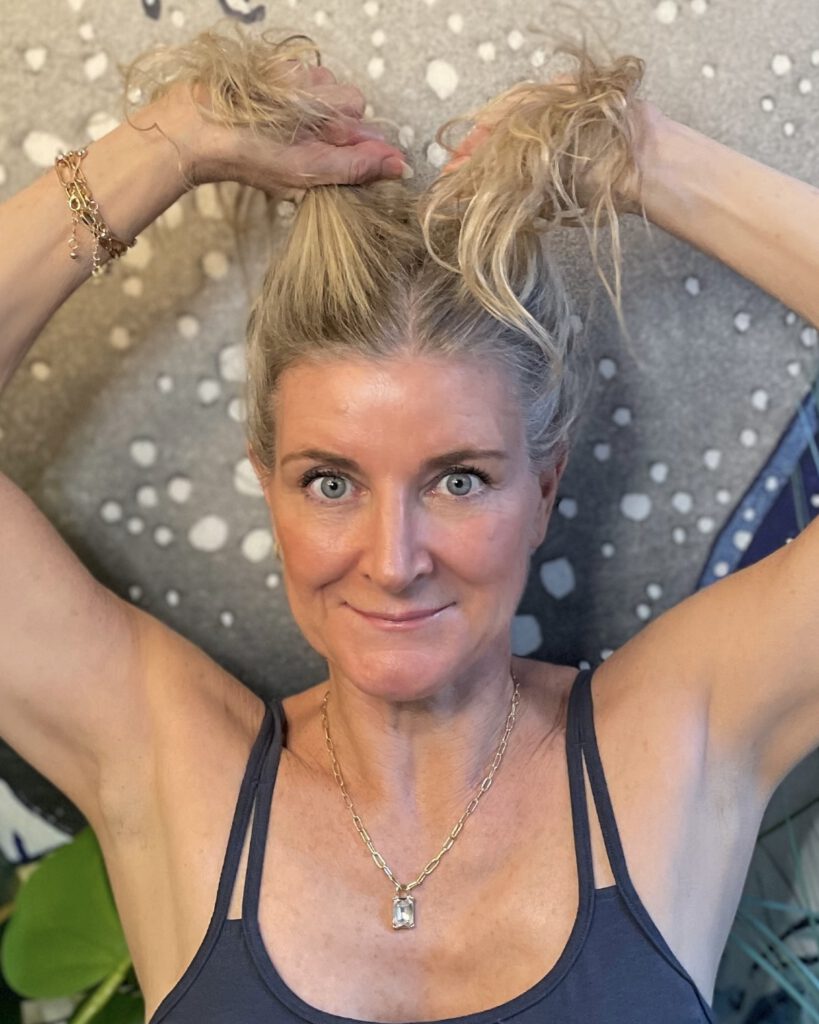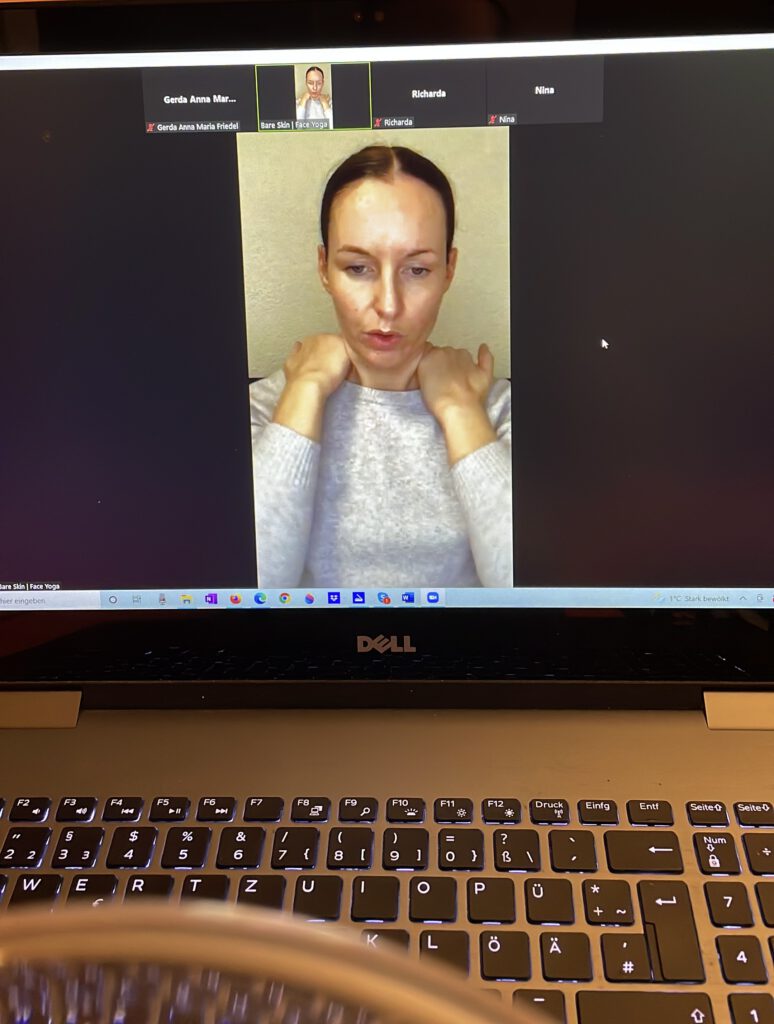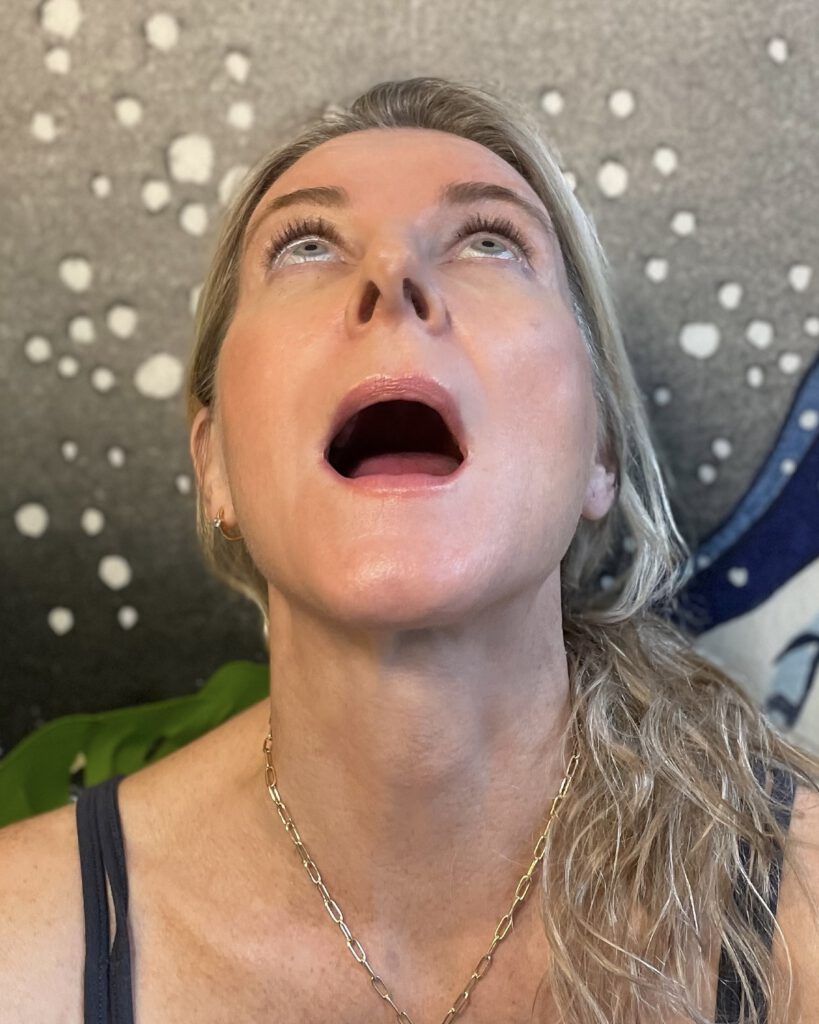Work your muscles – and don’t forget your face
Author: Gerda Friedel, MA, ALM
Date: 8/2023

I am sitting at my laptop gripping strands of hair between my fingers. Tugging them up and down, I am moving my hands from the back of my neck upward to the top of my skull and on to the forehead. I am not in a frenzy – just in the middle of a warm-up exercise for my face yoga online class. Five other so-called ‘face yogis’ have joined me on this Tuesday evening for my weekly online lesson. A mirror is in front of me and some herbal tea at hand. “Hydration is important,” my face yoga teacher Claudia says.
From the medical term ‘facial exercise’ to more popular names like face workout or face yoga, training your face is a trend – a huge trend – despite ongoing discourse over whether its benefits are scientifically valid.
As a 59-year-old health journalist, I deal with beauty and cosmetics daily – and I love to dig deep. Whatever fights wrinkles, I’m game. I admit I had not realized the hype about face workout: It has its own celebrities like Danielle Collins, Inge Theron or Fumiko Takatsu. The New York Times featured Gary Sikorski, face yoga adviser in a 2018- study from Northwestern University that says facial exercises may work against wrinkles and face sagging.
There are face yoga experts. Facial exercise research. Face workout shitstorms.
When Harvard Health Publishing asked “Can facial exercises reverse signs of aging?” and concluded that, “If they don’t make you look younger, these goofy moves will, at the very least, make you smile” – a bunch of commentators were not amused by this lax statement.
What are goofy moves in face yoga? Midway into the 60-minute session, we do the “flirty eyes”- exercise, which to me was more of a chicane than a flirt:
Placing the index fingers under the eyes, Claudia told us to pull the top and bottom lip away from each other hiding the teeth and to flutter the upper eyelids; then look up while trying to keep the forehead as still as possible and hold for 30 seconds. “This routine lifts and tones your upper eyelids, works the muscle around the eyes, and strengthens the lower face muscles,” Claudia said with big open eyes, her brown hair tied back, flawless contours without any makeup.
Claudia Granig, 38, has a master’s degree in art history and sports science. Before the pandemic, she was a project manager at Swarovski Crystal in Austria where she lives with her husband and little daughter. Home office and short-time work during lockdown gave her the chance to turn her passion for face yoga into a real-life job. In August 2020, after four months of training, she received an instructor’s license from the British face yoga expert Danielle Collins. Meanwhile, Claudia has become the face yoga ambassador for a German cosmetics brand and her classes are flourishing. Face yoga fits well into an online environment, she said. “You need to wash your face before workout, and you should be in a cozy place – all that works best at home.”

To catch up with Claudia’s current live class, I had followed her advice and worked with the recorded manual by myself. That was easy-peasy compared to the live session. Here, I practiced harder (group dynamics!), and I had not expected some moves to be that sweaty. For example, the plopping mouth movements during an exercise called “Hold the Pucker”, when you gently tilt your head back, bring your lips into a “pout position” and repeat for 30 seconds. Or “The Gecko” – a routine for the neck during which you turn your head to one side and slightly tilt it back, extend the tongue out and up, and hold for 15 seconds on each side. The next day my neck muscles were sore.

Dr. Rachele Pojednic is an assistant professor at Norwich University and lecturer at Harvard University with a specific focus on physical activity. In an online interview in December, I asked her how our face muscles work – and if I can pump them like my biceps. She said muscles of the face can grow and become sore just like any other skeletal muscle with actin and myosin filaments contracting in muscle movement. Touching her cheeks while talking, she went on to say that face areas like the cheeks – where we have many muscles – are more likely to puff up when trained.
Considering that roughly 20 percent of our entire muscle mass has been lost by the age of 80 according to a medical commentary on facial muscle training – and that this happens to our face as well – she said, “If you don’t use a muscle, your body is very efficient and so it’s going to essentially stop building that muscle, stop sending nervous signals to that muscle and essentially it starts to atrophy and consequently it gets smaller.”
After four weeks of regular training, I had the impression my cheeks were indeed puffier and the wrinkles under my eyes had lessened. After each session, I felt this tingling on my face –my skin was glowing and felt rejuvenated.

Subjective perception or scientifically valid?
The current understanding of face aging in medical science is that it consist of a series of events affecting all facial tissues, including bone, ligaments, fat, fasciae and skin. The idea behind facial exercise is that by preserving and building muscle, the fat pads in our face will more likely stay in place and make the face appear fuller and younger.
Associate professor Sebastian Cotofana is a specialist in the anatomy of the aging face. In a video talk from his office at the Mayo Clinic in Minnesota, he told me how face muscles affect the skin – especially in aging – and what he thinks about face workouts. “Face muscles are here to move the skin, and that’s a vital point,” he said.
Cotofana went on to say that skeletal muscles are usually connected to the bone on both sides, but facial muscles are different: At the skull, they connect to bone like all other skeletal muscles, but they insert directly into the skin on their other end and move the surrounding skin region. “On their way up [from the bone] they connect with the layers they cross,” Cotofana said, “and because they interweave with skin layers, they are able to move the skin above.”
When I asked him whether he thinks that facial exercises really work, Cotofana said that he initially did some in-depth reading about face workouts, but “the significance of the clinical improvements to me seems to be relatively low.” Also, the science-based evidence of the direct effect of the exercises on the skin is still missing. He went on to say that the workout might enhance blood supply to the face and that way lead to more volume especially in the fat pads, “and if it’s all in a better position, you look younger.” Also, despite the weakness in data it may still lift a patient’s well-being through better body awareness. “And that by itself improves quality of life,” he said.

In sum, scientific research on face workouts is relatively scarce. In a 2019-medical review, researchers from the University of Mississippi summarized current literature on the benefits of facial exercise for facial soft tissue. From four studies validated they found two that reported an increase in facial muscle size in middle-aged women. Still, the researchers stated that the link between these effects and facial rejuvenation remains unclear. They further pointed out that repeated face movements can form a groove beneath the skin surface and fine wrinkles may develop.
The fear of extra wrinkling was one of the few reservations I had against face yoga. “We use our hands to keep skin and muscles in place,” Claudia said. That way, the pressure of the hands makes muscles work harder and prevents the skin from folding.

Moreover, not all face muscles need a build-up. Some are better relaxed with a massage or acupressure, Claudia told me. “For instance, the muscle between the eyebrows,” Claudia said touching that spot with her index finger, “I would never strengthen it because it is generally overtrained, and it holds so much pressure, it needs to be relaxed with specific techniques.”
As with most workouts, consistency is key. In between online sessions, Claudia recommended I train my face muscles six times a week for best results. I admit after one first enthusiastic week I already packed up the second and I managed to practice with her video manual for 30 minutes three to four times weekly.
I am tapping my cheeks with my fingertips, slowly I am moving upward to the forehead, eyes closed, breathing in and out. Claudia’s soft voice is bringing me back to the here and now.
And where am I now? I wish I could say that my initial enthusiasm had turned me into a face yogi. Despite my glowing complexion, firmer feeling in my cheeks and a well-defined jawline, I guess I will spend 15 euros a week for an online session with Claudia to keep the spirit alive. I am sure there is a benefit to facial exercise—provided you dedicate the time and stick to your routine.
Face Yoga – dos and don’ts
Claudia’s recommendations:
- Wash your face and hands before your workout.
- Apply a plant-based serum onto your skin for moisture. Avoid overdosing to safeguard the grip of your hands.
- Position a mirror in front of you during workout for self-control. That way you should be able to detect unwanted wrinkling during exercise and reposition your finger grip.
- Have some water or tea at hand – you will get thirsty
- Watch your posture and be gentle on your shoulders
- Breathe deeply and slowly during exercise – calm and relax your mind!

References and further readings:
Abe, T., & Loenneke, J. P. (2019). The Influence of Facial Muscle Training on the Facial Soft Tissue Profile: A Brief Review. Cosmetics, 6(3), 50. https://doi.org/10.3390/cosmetics6030050
Alam, M., Walter, A. J., Geisler, A., Roongpisuthipong, W., Sikorski, G., Tung, R., & Poon, E. (2018). Association of Facial Exercise With the Appearance of Aging. JAMA Dermatology, 154(3), 365. https://doi.org/10.1001/jamadermatol.2017.5142
Amano, K., Naito, M., & Matsuo, M. (2020). Morphological study of human facial fascia and subcutaneous tissue structure by region through SEM observation. Tissue and Cell, 67, 101437. https://doi.org/10.1016/j.tice.2020.101437
Fratila, A., Schenck, T., Redka-Swoboda, W., Zilinsky, I., Pavicic, T., & Cotofana, S. (2016). The Anatomy of the Aging Face: A Review. Facial Plastic Surgery, 32(03), 253–260. https://doi.org/10.1055/s-0036-1582234
Freytag, L., MD, Alfertshofer, M., Frank, K., MD, Moellhoff, N., MD, Helm, S., Redaelli, A., MD, Voropai, D., MD, DM, Hernandez, C. A., MD, Green, J. B., MD, & Cotofana, S., MD, PhD. (in press). Understanding Facial Aging Through Facila Biomechanics. Facial Plastic Surgery Clinics. https://doi.org/10.1016/j.fsc.2022.01.001
Granig, C. (2022). HOME of FACE YOGA | Bare Skin | Face Yoga. BARE SKIN FACE YOGA. https://www.faceyoga.cc/
Hwang, U. J., Kwon, O. Y., Jung, S. H., Ahn, S. H., & Gwak, G. T. (2018). Effect of a Facial Muscle Exercise Device on Facial Rejuvenation. Aesthetic Surgery Journal, 38(5), 463–476. https://doi.org/10.1093/asj/sjx238
Liu, K., MD. (2019, February 20). Can facial exercises reverse signs of aging? Harvard Health. https://www.health.harvard.edu/blog/can-facial-exercises-reverse-the-signs-of-aging-2019022016042
Reynolds, G. (2018, January 10). Facial Exercises May Make You Look 3 Years Younger. The New York Times. https://www.nytimes.com/2018/01/10/well/move/facial-exercises-may-make-you-look-3-years-younger.html
Westbrook KE, Nessel TA, Hohman MH, et al. Anatomy, Head and Neck, Facial Muscles. [Updated 2021 Sep 25]. In: StatPearls [Internet]. Treasure Island (FL): StatPearls Publishing; 2022 Jan-. Available from: https://www.ncbi.nlm.nih.gov/books/NBK493209/